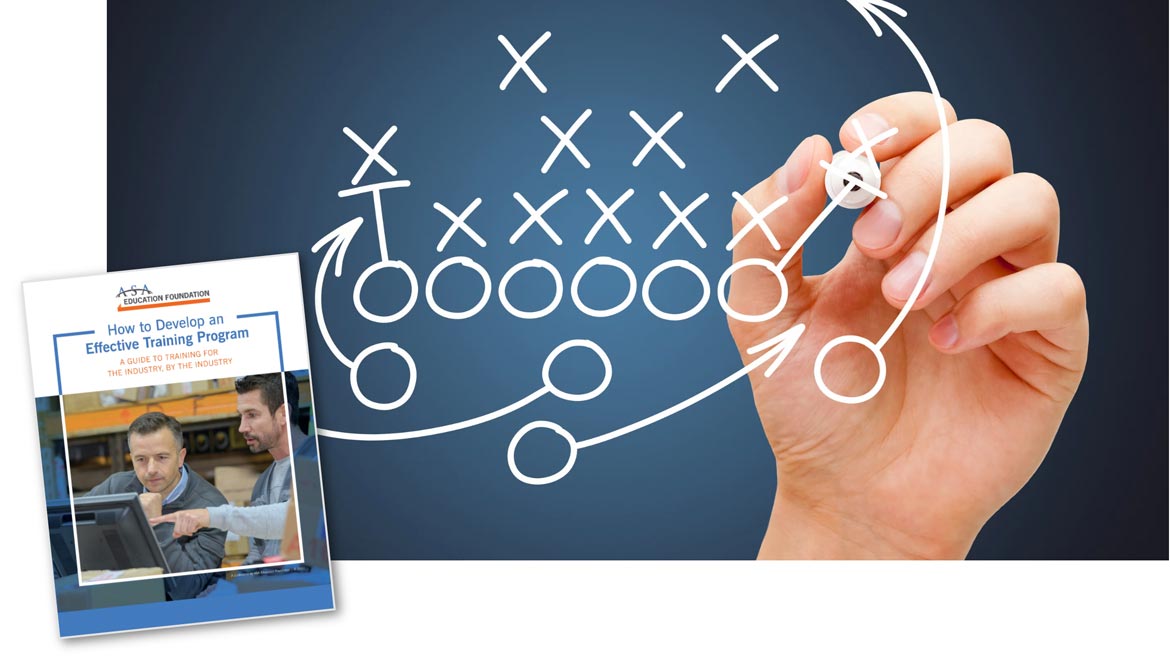New ‘playbook’ provides critical roadmap for developing a world-class employee training program.
What if you were the coach of a football team and someone dropped the opposing squad’s offensive playbook in your lap?
We’ve seen this scenario depicted fictionally on television and movies over the years and have even heard stories of real-life buffoonery where professional and collegiate players have left those books or iPad/tablets with the playbook on them (technological advancements) in places they shouldn’t.
Some good news for ASA members: ASA University is willingly leaving a playbook for all its members on a local park bench. Come and get it.
The recently released “How to Develop an Effective Training Program Handbook” is an in-depth, industry-developed guide that walks you through the entire process of creating an impactful training program. Authored by experts in training and development, each chapter focuses on a specific part of the training process and includes best practices, storytelling and results-based solutions to help your company address its training needs.
And when we say the book is authored by experts in training and development: we’re talking about ASA members — your friends in the industry, colleagues and competitors. People who walk the walk and talk the talk every day when it comes to employee training and education.
Through storytelling and connecting real-life experiences to best practices, ASA members share how they addressed challenges, overcame hurdles and celebrated success in their own training initiatives. You will learn how to motivate employee engagement and retention with training, how to develop and map job descriptions for skilled workers or how to set benchmarking indicators for your company’s training program and employees.
The book is dynamite and can be of help to all ASA-member companies regardless of where you are on your education/training journey — from having no training program in place and chucking new hires into the fire head-first to having a world-class training program that only needs a few tweaks to send it into the next stratosphere.
Specific topics in the handbook include:
- Why training is essential for long-term success in a company?
- Laying the groundwork for effective program management.
- Types of training programs and engagement through creativity.
- Conducting needs assessments.
- Buy-in and problem-solving.
- Developing learning objectives.
- Types of learners and training strategy shifts
- Career pathing
- Benchmarking, evaluation and post-training reinforcement
- Timing, relevancy and launch cycling
- Marketing and communications
- Celebrating your success
Through storytelling and connecting real-life experiences to best practices, ASA members share how they addressed challenges, overcame hurdles and celebrated success in their own training initiatives.
HOW TO I GET A COPY?
Here's the great part of this handbook. It’s free to all ASA members. Shoot me an email at mmiazga@asa.net and we will get a copy mailed to you right away.
LIVE TRAINERS FORUM
As written about in the accompanying ASA News section in this September issue, The ASA Education Foundation/ASA University is bringing this book to life with the inaugural ASA-U Trainer’s Best Practice Forum, an in-person, two-day event in Chicago in late October that will support ASA trainers and their ability to leverage best practices in training and development at their organization.
See the ASA News section in this issue for full details on this new in-person offering that already has drawn significant interest from ASA-member firms. Interested in coming to Chicago for this event? Contact ASA Vice President of Education Taylor Kenney at tkenney@asa.net for registration information.
2022 OPERATING PERFORMANCE REPORT NOW AVAILABLE
When I was growing up, there still were quite a few “afternoon” newspapers floating around.
For those unfamiliar with the term, an afternoon newspaper was one that was delivered to your doorstep around 3-4 p.m., as opposed to the more traditional method of having it waiting on your driveway when you woke up.
When I would stay at my aunt and uncle’s house on Thursdays while mom got her hair done, the paperboy would drive around the neighborhood chucking papers on driveways at 4 p.m.
Later, I ended up working as a sportswriter for that very afternoon paper and was able to witness that unique production process where the paper would be approved and printed the next morning, as opposed to the previous late evening. That paper eventually ditched the afternoon model.
Speaking of hot off the presses, I want to bring your attention to the recently published 2022 ASA Operating Performance Report, or OPR as it’s called. As I have mentioned in this space multiple times, including earlier this year, the OPR, now in its fourth decade of publication, is regarded as the gold standard for benchmarking for distributors in the PHCP-PVF industry.
The nearly 100-page book, has every financial data point you could ever imagine and then some, allowing ASA-member distributors to benchmark themselves against the industry, distributors that sell similar product categories as they do, by sales volume and by geography.
Of note here, is the inclusion in this year’s OPR of a special report on profit planning and how that technique is key to performance improvement control during any business climate.
From the report, penned from our friends at Industry Insights, ASA’s longtime business intelligence partner:
“The mere discovery of company strengths and weaknesses using ratio comparatives will not result in remedies to your financial problems. These are only tools—though important areas—for measuring the performance of your business. It is the use to which you put these ratios that will determine their real value.
“One important usage of financial ratios is for ‘profit planning’ or ‘budgeting for profits.’ Essentially, a budge is a tool used for planning and controlling the future performance of the business. However, it is more than a forecast. It is a formal expression of management’s policy and thinking in terms of definite goals for the future, in terms of sales volume, product mix, authorized personnel and pay practices, cost and expense control. Ideally, budgets should be prepared with a ‘profit objective’ in mind. In other words, a bottom-up approach is recommended whereby the company determines the desired profitability level and budgets expenses accordingly.”
This section goes on to list five key steps in the profit planning process. This is yet another example of why this report is a yearly must-have for ASA distributor members (and non-ASA distributor members in our industry for that matter). A manufacturer and a rep could also gain plenty of insights from a conceptual/topical standpoint from this report. Maybe you find that one missing financial piece in this book that will help you turn a profitability corner? Certainly worth checking out.
If you did not contribute data to this year’s report and would like to purchase a copy, contact me at mmiazga@asa.net. I also have a sample report I can send so you can test-drive, so to speak, before you buy.





